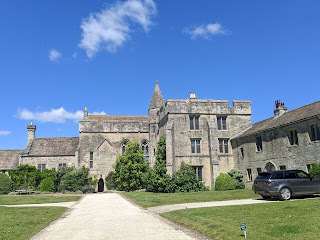S.M. Harrison's Blog
February 8, 2023
RESEARCH TRIP TO CHESTER UNIVERSITY FOR YET ANOTHER WIP...
 If I told you the MC (main character) was involved in the sieges of Orleans and Jargeau and was defeated by Joan of Arc can you guess who he is?
If I told you the MC (main character) was involved in the sieges of Orleans and Jargeau and was defeated by Joan of Arc can you guess who he is?

EXCERPT SUNDAY - WIP 'FOR KING AND COUNTRY' Jack de Laver...
EXCERPT SUNDAY - WIP 'FOR KING AND COUNTRY'
Jack de Laverton is in serious trouble and, not for the first time, a woman is the cause! (I haven't given you her name on purpose!)

For a moment Jack thought his heart had stopped beating. ‘What?’ he asked. His smile died. His mind turned his thoughts into somersaults. ‘Why would you want to go there?’ he cried. ‘Unless...unless –’ The truth slapped him: so she was Lancastrian!She tightened her grip on his hands and as she closed her eyes, Jack saw tears begin to bead on her fluttering lashes. ‘I’m sorry,’ she murmured. ‘I had no choice, Jack.’Sweet Jesu! What a fool he was! Jack snatched his hands from hers and stood up. She was Lancastrian and he’d brought her half way across England! Christ’s wounds, he was ten times a fool!‘Look at me, Jack,’ she commanded. ‘Do I look like an enemy to you? Will I bring down castle walls or steal the crown of England from Edward’s head?’Jack barely heard her. He ran his hands through his hair as he began to pace the space beneath the altar steps. God’s teeth, Will Kennerley would not believe this. And worse still – what would the Earl of Warwick think of him if he knew? This was a disaster! John Neville would hang him for certain if he knew he'd harboured a Lancastrian spy in their midst!But she hadn’t finished. ‘Jack, answer me!’ she pleaded. ‘I am just like you. Like you I cannot change my birth!’Jack looked at her again. Tears slid along her soft cheeks and her wide eyes glistened with more of them. He wanted to wipe them away; tell her not to cry, but how could he? By God's Holy blood, she could be the death of him!#smharrisonwriter #medieval #forkingandcountry #WarsoftheRoses #wip #amwriting #historicalfiction #Kingmaker #excerptsunday
October 3, 2022
👑👑ANNUAL GENERAL MEETING OF THE RICHARD I...
👑👑ANNUAL GENERAL MEETING OF THE RICHARD III SOCIETY LEICESTER. 👑👑
 Archaeologist Dr Tim Sutherland, expert on Towton battlefield:
Archaeologist Dr Tim Sutherland, expert on Towton battlefield: Wounds on victims from Towton 1461:
Wounds on victims from Towton 1461: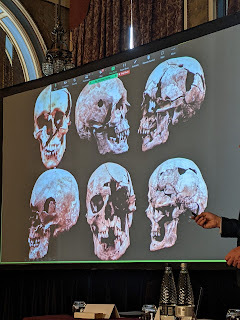 How to get your armoured man:
How to get your armoured man: 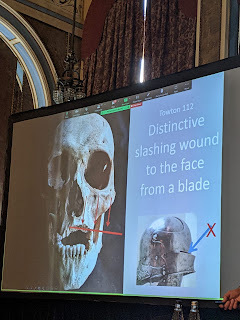
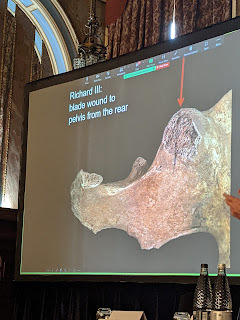
 A bit of Talhofer:
A bit of Talhofer: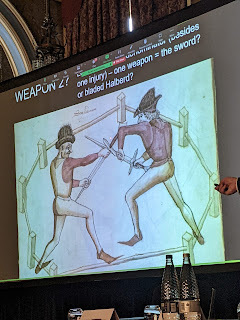 Richard III Society Chair Matt Lewis:
Richard III Society Chair Matt Lewis: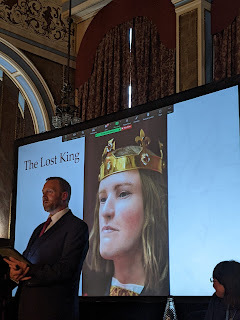 And a mini book haul too!
And a mini book haul too!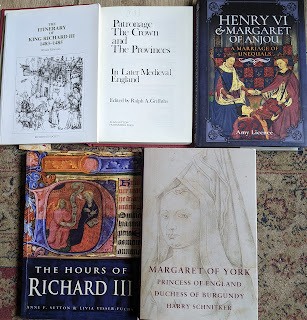
July 20, 2022
👑👑👑RICHARD III AND SIR THOMAS MA...
As my new WIP comes up to Bosworth Field, I may have found a new character we haven't met before: Sir Thomas Markenfield. Quite how he will fit with Thomas Conyers and Sir John de Laverton we will have to see, but it's certainly going to be interesting - you know what Jack is like!!!
Markenfield Hall is in North Yorkshire, near Ripon. The present house dates back to 1310 when "Licence to John Merkyngfeld, King's Clerk, to crenellate his dwelling house at Merkyngfeld Co. York 2 Feb 1310" was granted. The nearby lordships of Middleham and Sheriff Hutton were inherited by the 'junior' branch of the Neville family in 1453 and had been administerd by Richard Neville, 16th Earl of Warwick until his death at Barnet in 1471. Edward IV knew how vital these lordships had been, both to Warwick's northern powerhouse, and to maintaining the border with Scotland and therefore granted these estates to his then 18 year old brother, Richard duke of Gloucester.
Since the fourteenth century the manor of Markenfield had leaned towards the Nevilles, even though the Percy manors of Spofforth and Topcliffe are closer to Markenfield than Middleham. This was because most of the family's estates were in Richmondshire and the feudal infrastructure of the independant lordship of Richmond meant that military service remainded at the heart of the relationship with the lords of Richmond, which had been the Nevilles since Ralph Neville had been granted the lordship by Henry IV. The lordships of Middleham and Richmond were integrated into one administration, and it was this complex of Warwick's that Edward IV settled on Gloucester and with it the allegiance of the Markenfields. In 1431-2 John Markenfield had served under Richard Neville, earl of Salisbury (father of the earl of Warwick) in France.

It is not known when Thomas Markenfield married Sir John Conyers' (the steward of Middleham) daughter Elinor, but when he did so, he was joining the family business. Markenfield was formally retained by Gloucester on 11th December 1471. He was paid a fee of £10 per annum from Middleham, the fourth highest fee of the 27 knights and esquires retained by Gloucester up to September 1473. Pollard has suggested that a personal bond formed between Gloucester and Markenfield as, unlike most of the retainers, Markenfield was only some 5 years older than Gloucester. Markenfield's second son born c1476 was named Ninian. Ninian was a saint known to be favoured by Gloucester, and it is possible that Gloucester was a Godfather to the child, who may have been Christened on the saint's feast day of 16th September.
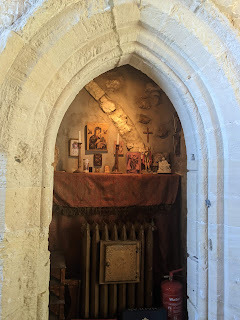

There is no record of Markenfield's service to Gloucester before 1483, but as the indentures from Middleham were most importantly militrary in aspect, as with Warwick, it is likely that Markenfield went with Gloucester to France in 1475 and perhaps shared with him the disappointment at Edward IV's settlement. He probably also campaigned in Scotland with Gloucester in 1481 and 1482.
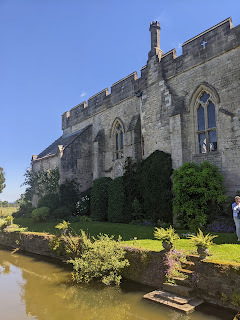
He was later made a knight of the body to Richard and pricked as sheriff of Yorkshire and by the end of 1484, Sir Thomas Markenfield was at the very heart of Richard III's regime.
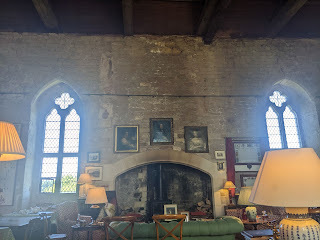
 It is unclear whether Markenfield fought at the Battle of Bosworth. The 'Ballad of Bosworth Field' identifies him as one who came to the king on the eve of the battle, which would then mean as a knight of the body he would have fought alongside Richard and participated in the last charge. However, as sheriff of Yorkshire his duty was to raise troops for the king in the company of the earl of Northumberland who, for whatever reason, did not engage. Since Markenfield was not among those charged with treason by Henry VII (dating the start of his reign to the day before the battle!) it is unlikely that he fought, though he was one covered by a genreal pardon to the men of the north. He did take out a pardon, though specifically for his period of service as sheriff, as was usual practice. He was not one of the Ricardians placed under a hefty bond for future good behavior by Henry VII and attended upon him in York in May 1489. He came to terms with the new regime, much as his father-in-law, Sir John Conyers had done throughout the previous turbulence, and, as Henry Tudor was the true earl of Richmond it was perhaps the older fealty that held sway, especially as Markenfield had only been retained by Richard for the duration of Richard's lifetime.
It is unclear whether Markenfield fought at the Battle of Bosworth. The 'Ballad of Bosworth Field' identifies him as one who came to the king on the eve of the battle, which would then mean as a knight of the body he would have fought alongside Richard and participated in the last charge. However, as sheriff of Yorkshire his duty was to raise troops for the king in the company of the earl of Northumberland who, for whatever reason, did not engage. Since Markenfield was not among those charged with treason by Henry VII (dating the start of his reign to the day before the battle!) it is unlikely that he fought, though he was one covered by a genreal pardon to the men of the north. He did take out a pardon, though specifically for his period of service as sheriff, as was usual practice. He was not one of the Ricardians placed under a hefty bond for future good behavior by Henry VII and attended upon him in York in May 1489. He came to terms with the new regime, much as his father-in-law, Sir John Conyers had done throughout the previous turbulence, and, as Henry Tudor was the true earl of Richmond it was perhaps the older fealty that held sway, especially as Markenfield had only been retained by Richard for the duration of Richard's lifetime. Sources: North-Eastern England During the Wars of the Roses: Lay Society, War and Politics, 1450-1500. A J Pollard (1990)
Sir Thomas Markenfield and Richard III A J Pollard The Friends of Markenfield Hall 8
The Markenfields of Markenfield Hall Janet C Senior
June 27, 2022
A WARWICK! A WARWICK! It has been a while since I've vis...
A WARWICK! A WARWICK!
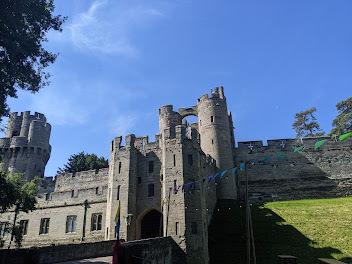
It has been a while since I've visited the favourite home of our hero, Richard Neville 16th Earl of Warwick. Warwick Castle came to him, aged 20, as earl of Warwick in right of his wife as part of her Beauchamp inheritance and it seems that Richard identified strongly with the Beauchamp legacy. Keeping possession of the inheritance was however not easy. As Anne de Beauchamp's late brother, duke Henry of Warwick had attained his majority and received livery of his estates, the whole should have passed to his only surviving sister, on the grounds of the exclusion of the half-blood (the half sisters by their father's first wife).

There were three elements: the Beauchamp estates which the new Countess inherited from her brother; the lordship of Abergavenny in which she was also sole heir of her brother; and the Despenser estates, in which she was the joint heir of her mother. There were other elements that Richard Beauchamp had put in Trust. The half sisters did not hesitate to claim a quarter share each of the Beauchamp estates not in Trust, and John Talbot, earl of Shrewsbury, as husband of the eldest daughter Margaret, even had hopes of the title himself! The inquisitions post mortem when eventually held unanimously concluded in every county that Warwick's countess was the sole heir. The sisters continued to contest the decisions and the new earl spent much of his time fighting (at times literally) to keep hold of and even gain estates. The sisters had no claim to the Abergavenny or Despenser lands buyt the descent of these was complex due to the intermarriage of cousins.Warwick annexed all the Despenser lands, even though only half ewre his countess's by right. The earl's possession was endorsed by key Beauchamp councillors, administrators and retainers including Nicholas Rody, Thomas Hugford, and William Berkeswell, dean of St Mary's Warwick who had served Beauchamp since the1420's or earlier. Others also moved to Warwick's service and were key supporters of his countess as sole heir to the Despenser estates.

Warwick spent much of his time residing at Warwick and visiting neighbouring lordships. He enthusiastically adopted the traditions of the earldom, in relation to the bear and ragged staff and the legend of Guy of Warwick as founder of several monasteries, espcially Tewkesbury, as patron of Guy's Cliffe chantry and the collegiate college of St Mary's at Warwick where the famous Beauchamp chapel under the offices of these men, was being built - but that's another post!


Ref: Warwick the Kingmaker Prof A J Pollard Continuum 2007
June 1, 2015
Character Blog Hop
I have been tagged in the Meet My Character Blog Hop by fellow indieBRAG honoree author and historical re-enactor Paula Lofting and if you click the link you will be able to read her excellent post about her amazing character, Wulfhere. These are the questions Paula asked me: What is the name of your character?
Jack de Laverton
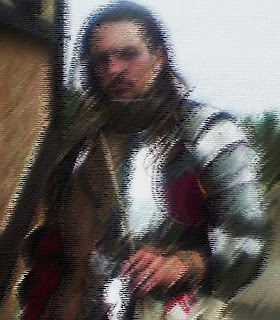
Is he/she fictional or a historic person?
Jack is a fictional character fast developing his own fan club! He was described by one reviewer as 'half knight in shining armour, half seductive rogue'. I regularly get asked when there will be another novel involving Jack.
Although Jack is fictional his experiences are typical of those caught up in the dark times of what we know as the Wars of the Roses, where blood wasn't always thicker than water!
When and where is the story set?
Jack’s character was prominent in ‘The Colour of Treason’, but the new book is set some 10 years earlier in the Wars of the Roses, at the Battle of Towton in 1461, where we learn the origin of Jack’s conflict with the hateful Master Higgins. This book is the first in a planned series of Jack’s adventures.
What should we know about your main character?
Trouble has dogged Jack’s existence from his illegitimate birth to the baggage cart her finds himself in on the eve of the Battle of Towton; the battle which sees Edward of March gain the throne of England and become Edward IV. Edward's hold on power is tenuous as the Lancastrians flee into the English/Scottish border lands, later famous for the Border Reivers.
What is the main conflict? What messes up his/her life?
Jack’s illegitimacy puts him in conflict with everyone as he sees the world quick to judge him harshly.
However a single act of courage brings Jack to the attention of the most powerful man in the country, the Earl of Warwick, and Jack enjoys rewards he could not have dreamed of. But things go badly wrong when Jack is betrayed and is forced to leave the earl’s company, unable to clear his name.
What is the personal goal of the character?
Jack encounters a brutal enemy – Sir Robert Hasard, a man with strong influence in the wild border lands, who is also in possession of the thing Jack desire’s the most, his father’s ancient black sword. Without the sword Jack cannot return home and cannot lay claim to the inheritance his father promised him. And Jack being Jack, of course there is a woman involved too!
Is there a working title for this novel, and can we read more about it?
The book’s working title is ‘For King and Country’. There is a draft preview to read on my website: http://www.smharrisonwriter.com/for-king-and-country
When can we expect the book to be published?
If Jack behaves himself - late Autumn 2015!

June 23, 2013
When you watch The White Queen tonight...
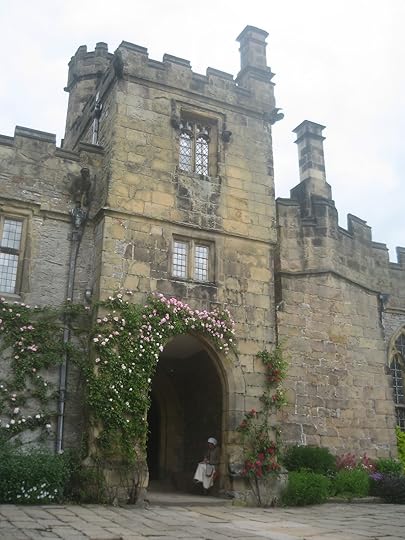 And yesterday The Tudor Group were there presenting a Tudor wedding, complete with wedding breakfast, Tudor games and dancing. I was so impressed by the Tudor Group; their kit is amazing, their research thorough and their knowledge extensive and it was great to chat about the similarities and differences between 'our' periods.
And yesterday The Tudor Group were there presenting a Tudor wedding, complete with wedding breakfast, Tudor games and dancing. I was so impressed by the Tudor Group; their kit is amazing, their research thorough and their knowledge extensive and it was great to chat about the similarities and differences between 'our' periods. 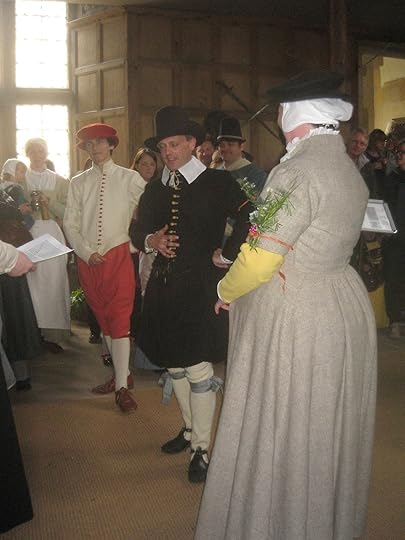 We talked about the etiquette and ceremony of a Tudor (or medieval) feast - the luxury of choice, the reverence with which the servants treated their betters, even when encountered in the garden (reminded me of Kim Phillips' excellent paper on the Earl of Warwick at Middleham) and the pride with which the household liveried retainers wore their badges.
We talked about the etiquette and ceremony of a Tudor (or medieval) feast - the luxury of choice, the reverence with which the servants treated their betters, even when encountered in the garden (reminded me of Kim Phillips' excellent paper on the Earl of Warwick at Middleham) and the pride with which the household liveried retainers wore their badges.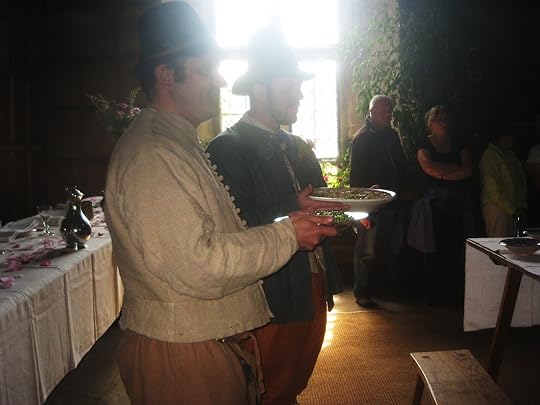 Servants bring the first dishes.
Servants bring the first dishes.
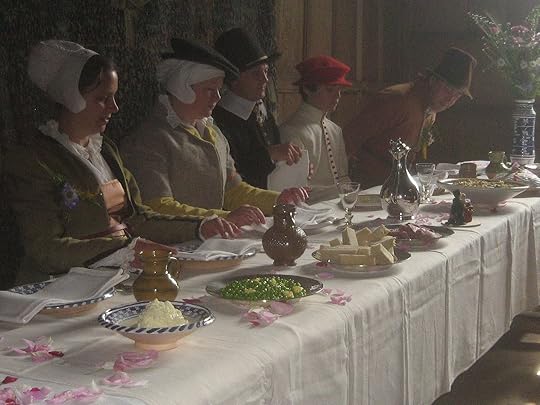 Double linen and the best majolica for the top table!
Double linen and the best majolica for the top table!
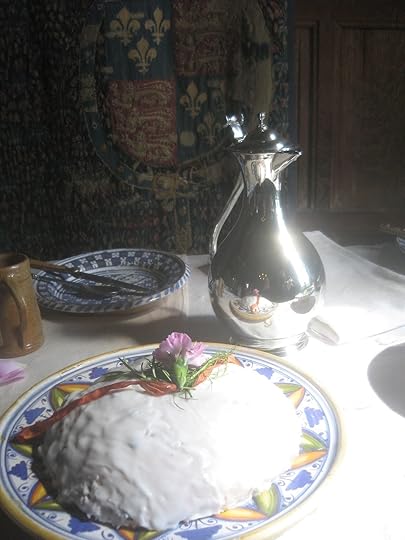 The 'Bride Cake'.
The 'Bride Cake'.
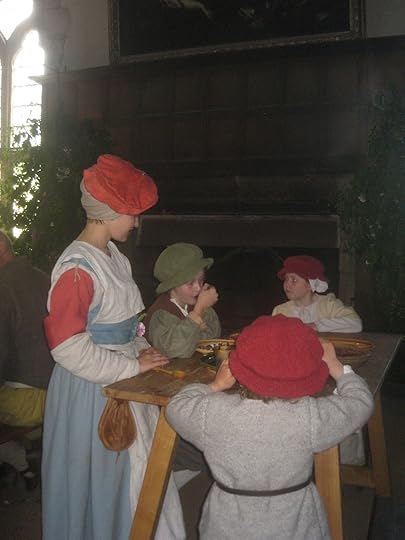 Children weren't allowed to sit until they showed enough maturity to do so!
Children weren't allowed to sit until they showed enough maturity to do so!And of course The White Queen was mentioned - why? Because you won't see any of this in the BBC dramatisation (we talked about actors' reluctance in wearing hats or in Max Irons' case not adopt the hairstyle either!). Such a shame that the actors and producers missed a wonderful opportunity to educate as well as entertain the public as the Tudor Group did so brilliantly.
 Dancing in the garden.
Dancing in the garden.Reference:
Kim M. Philips Journal of Medieval History 31 (2005) 143 'The Invisible Man: Body and Ritual in a fifteenth-century noble household.
June 9, 2013
'Sons of the Wolf' Blog Tour

Hi Paula, I believe this is your first novel; why did you decide to write ‘Sons of the Wolf’? Hi Su, let me start by thanking you for agreeing to host me on the opening day of my blog tour. It’s great to be here, especially on your fantastic blog. I’ve been an admirer of your work for some time! Well, to answer question number one, it had always been my dream to write a novel of some sort ever since I was a kid, daydreaming in my composition class at school. I never could write short stories, I was only able to write ones that went on forever and I struggled to get them finished. My mind was like woven cloth, with so many threads running through it. Sons of the Wolf was a late inspiration, mainly because throughout my life, the dream became a distant memory as other paths took me away from what I had always wanted to do. Life does that sometimes. Later, I found myself re-evaluating life after a marriage breakdown and some really dark times. I started reading again and the urge to write gnawed and nibbled at me until I just had to write that epic novel I was always meant to. That it would be historical fiction was a given. After perusing with ideas and eras, I was finally inspired when I watched a re-enactment of the Battle of Hastings, and when I stumbled on a book by David Howarth’s 1066, The Year of The Conquest, I knew I had my story.
Although ‘Sons of the Wolf’ is a work of fiction it is based on historical fact. How did you go about researching it? After I had decided on my subject, I started researching articles about the 11thc on the net and stumbled across www.regia.org website and found that apart from some really interesting, useful articles, they also did living history and battle re-enactment and thought that it would be a wonderful way of learning firsthand what it was like to live a thousand years ago in England. I contacted them and found that they had a group in Sussex where I live. Having joined them, I now realise that the enjoyment of re-enacting far outweighs the enjoyment of the research aspect. It’s a great life and I wish I had joined earlier. For the events and politics of the time I read widely and look for primary sources to ensure as much accuracy as possible.
Do you feel any responsibilities as a writer of historical fiction? Definitely. Everyone has something to say about this don’t they,J. I know that there are lots of authors and readers who are not too fussed about historical accuracy and that’s fine, but for me, it wouldn’t feel right if I didn’t at least try to stick to the facts as far as I possibly can interpret them. I wouldn’t feel comfortable with changing or making up facts to suit my story and I wouldn’t want to attribute good or bad deeds to a historical figure if it were not true.
What can a modern readership learn from the hardships of Wulfhere and his family and the Anglo Saxons in general? Probably the first lesson would be not to take for granted our nice cosy lives and to appreciate and respect our ancestors for paving the way for us. If not for their hardships, we would not be the people we are today. It was a hard cruel world, for both the peasants and the nobility. Families like the Wulfheresons from my story, enjoyed the comforts of plenty of food, servants to help them, decent clothing and a great hearth to warm their home, but they still endured hardships such as having their crops ruined by weather; damp, cold drafty rooms; illness and untimely deaths caused by something as minor as a witlow on their fingernail; death in child birth; invading marauders; it often made no difference what your status was, it was a hard life for everyone, though much harder for some others. No soft toilet roll to use in a nice flushing loo; no antibiotics to cure your infections; shivering in long cold winter nights. Wulfhere might have been a thegn (a low-ranking noble) but he still would have had to chop wood for fuel, work hard mending bridges and fencing around the King’s demesne as well as maintaining his own buildings. His wife Ealdgytha would have spent her day spinning wool, weaving cloth or sewing clothing for her family. She would have had to see that everyone was fed and watered and oversee the work around the home and make sure the farm ran smoothly. I think we also take for granted today that we have the potential to live long healthy lives, in medieval times, if you survived past 5 years old, you might be lucky to live till you were 25, perhaps less if you were female, with the chance of dying in child birth. I could probably go on forever!
What are you currently working on? I’m currently working on the sequel to Sons of the Wolf, The Wolf Banner. It follows Wulfhere’s fortunes further and leads us closer to the Battle of Hastings. It also continues with the fortunes of the historical characters of that time too.
And finally, where can readers learn more about your work?
My website is: http://www.paulalofting.com/
And 'Sons of the Wolf' is also available from Amazon in both the UK and US.
Thanks Paula, it's been great to chat with you!
IndieBRAG: Your source for quality self-publishing.
April 11, 2013
'The Colour of Treason' wins an award
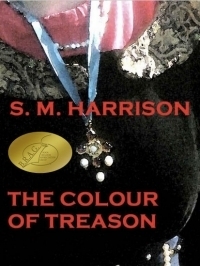 I am pleased to announce that 'The Colour of Treason' has been awarded an indieBRAG medallion and now has it's own page on the indieBRAG website!
I am pleased to announce that 'The Colour of Treason' has been awarded an indieBRAG medallion and now has it's own page on the indieBRAG website!
April 1, 2013
'The Violent Death of the King in the Car Park'. Talk by Bob Woosnam -Savage Royal Armouries, Leeds, Wednesday 27th March 2013.
Robert talked for over two hours about the prelude to Bosworth, the setting of the battle and the drawing of battle lines and their subsequent redrawing recently when the largest concentration of shot from any medieval battlefield in Europe were found by Dr Glenn Foard of the Battlefield's Trust and his team. So far 30 - mainly 25-65mm; but the largest 93mm weighing 7.2 Kg - which put the site beyond doubt. And the subsequent treatment of Richard's body with it's eventual burial at Grayfriars in Leicester and these are a summary of some of the notes I took.
At the site: Skeleton found on the first day less than 1 car’s width from the ‘R’ painted on the car park! The main focus of his talk was on the wounds and how they might have been inflicted and what these could tell us about Richard's last moments.
Analysis:
The skeleton was from a Caucasian male ~35 years of age.
There were 12 wounds on the body - 9 Cranial and 3 post-cranial. This is higher than the average number of wounds from those recovered at Towton which was 4.2, though the highest at Towton was 14.
This is likely to be an underestimate as there would probably also been flesh wounds - wounds that left no trace on the skeleton. Small teeth - especially back ones and had lost 1st left upper molar.
Suggestion that the hands were still tied at the time of burial by their position. There was no evidence of coffin or shroud and the hole was not large enough for the body therefore the skeleton is rather crumpled. The feet were missing.
Richard’s standard bearer at Bosworth Sir Percival Thirwell died after having his feet sliced away during the battle, possibly with a two-handed sword but more likely with a bill or Halberd - however Richard’s feet were likely lost to previous building on the site (Victorian toilet).
On examination the spine showed significant scoliosis, this developed at puberty and increased in severity with age.
There is still much work to be done on how this affected Richard but likely that his head would be off centre - over to the right.
If his spine had been normal he would have stood about 5’ 8’’ in height but with his spinal deformity he could have been up to 1’ shorter - however if this extreme was the case it is likely that this would have been mentioned by contemporaries.
Wounds were classified using experience of forensics team and using as a guide the cranial trauma identification chart developed by Caroline Needham in 1999.
Evidence of ante-mortem wounds? Was there any evidence for the injuries that Richard was known to have suffered at Barnet? Nothing so must have been a flesh wound only.
Contemporaries state that Richard died leading a charge against Henry Tudor.
It is known from contemporary accounts that the Earl of Oxford told his men to ‘stay within 10’ of your standard’. (Vatican record has 4’ but this has then been crossed out).
Richard kills Tudor’s standard bearer Brandon - so must be very close to Tudor - may have even crossed swords with him if he was that close to his standard.
Why did he charge?
Desperate move as the battle was turning against him?
Deliberate brave move - almost made it!
Charge stalled by - men + marsh?
Accounts say Richard fights on foot and kills several men -
Horse either stuck in the marsh or slain?
? chose to dismount as English tended to fight on foot.
Richard is well protected but his armour fails under a ferocious attack.
Evidence:
Wounds
1. Right sided cuts to the jaw:
a) Lower jaw
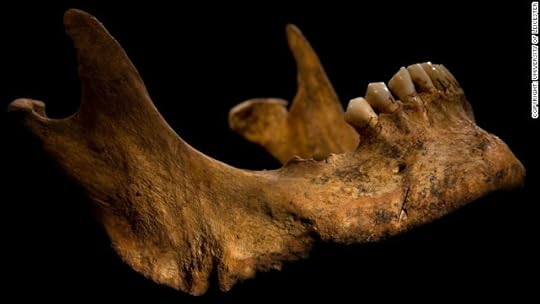
b) Near hinge point. These were delivered by a knife possibly cutting away the strap to forcibly remove his helmet. Bone chipped away ~ 5mm in length.
2. Penetrating wound to right maxilla Small rectangular hole. Relatively fragile bone. ? delivered post mortem or from behind. This could not have been delivered with helmet in situ. This was not an attempt to kill but would have been painful. Has a square profile - likely a dagger strike.
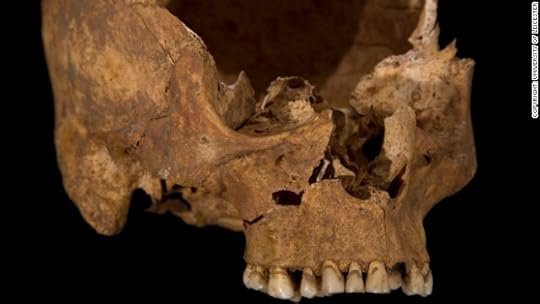
3. Wounds to the top of the head
(a) Left posterior cranium. Outer surface of the skull removed (death star appearance). This was from a bladed weapon - striations/curve or ‘scoop’ up from the base.
(b) Second scoop can be seen and the striations can be compared to see if this is from the same weapon. Neither of these blows were fatal nor were they attempts to scalp, though they would have lifted flaps of skin resulting in a lot of bleeding. Similar to Towton 11.
(c) Non-fatal penetrating would to the top of the skull; has a rectangular profile so likely a dagger (Rondel). No fractures near this wound so not percussive force. A ‘key-hole’ wound ~2-3mm wide. This did not go all the way through but dislodged 2 small bits of bone so was delivered with some force. Richard would be on the ground so there is likely a 2-handed delivery.
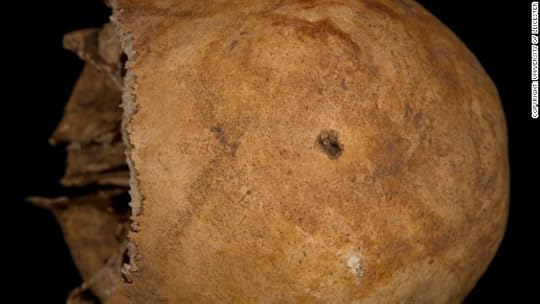
4. Occipital wounds (posterior base of the skull)
(a) There is a large wound to the right occipital which although possibly not fatal would have exposed the brain and there would have been a lot of blood. Seen in top of picture below.
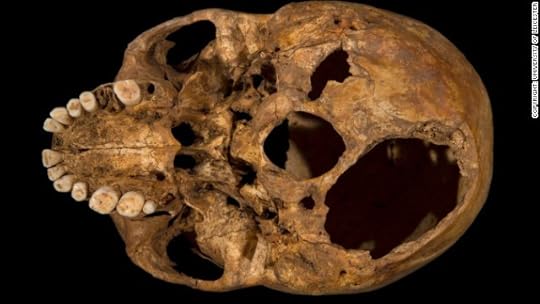
(b) Penetrating wound to the left occipital which goes all the way through (~100mm in length) and has marked the inside of the top of the skull. This would have been fatal.
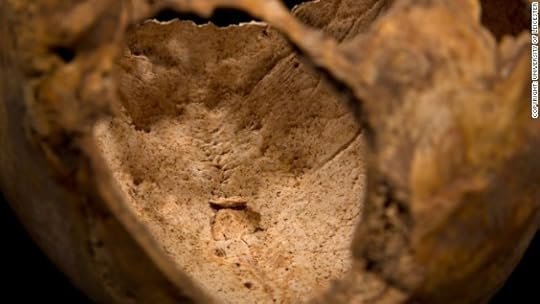 Blows likely dealt with Richard on the ground - either kneeling or in a probe position. Interestingly these may fit with some contemporary writings about Richard’s death:
Blows likely dealt with Richard on the ground - either kneeling or in a probe position. Interestingly these may fit with some contemporary writings about Richard’s death:Jean Molinet was historiographer to the Burgundian court and sympathetic to the Yorkist cause. His account of Bosworth in Chroniqueswas written c.1490. He interviewed veterans after the battle. In it he states: ‘One of the Welshmen then came after him, and struck him dead with a halberd’.
Other contemporary evidence comes from a poem by a Welsh poet called Guto'r Glyn. He composed a poem in praise of Rhys ap Tomos, one of the main supporters of Henry Tudor in his campaign. Rhys led an army of Welshmen to support Henry on the battlefield at Bosworth, and was then knighted for his services to the king. Not long after, Guto'r Glyn sang a poem in praise of his exploits, and he talks about the killing of Richard. He actually says Richard’s head was 'shaved'. This had previously been understood in a figurative sense; perhaps that his head had been chopped off. But it seems from looking at the wounds to the skull, that this was meant quite literally: that someone had chopped across the top of his head, cutting off a chunk of his hair and a bit of skull with it.
5. Other wounds
These could only have been delivered to an un-armoured man therefore are post-mortem and are humiliation or insult injuries.
(a) Nick in the right 10th rib just above the kidney ~5mm in length - possibly from a sword or dagger.
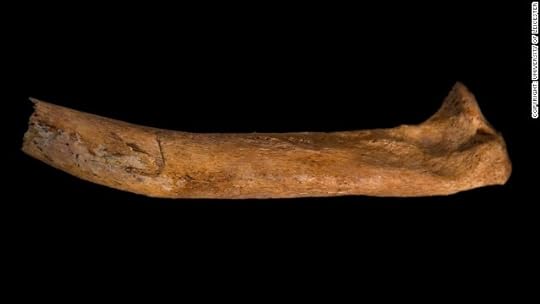
(b) Pelvis trauma. This is a fine wound ~30mm in length and is a cut delivered by a knife. It is seen just right of the midline and goes through the right buttock. Possible that this was delivered with Richard slung over the back of a horse.
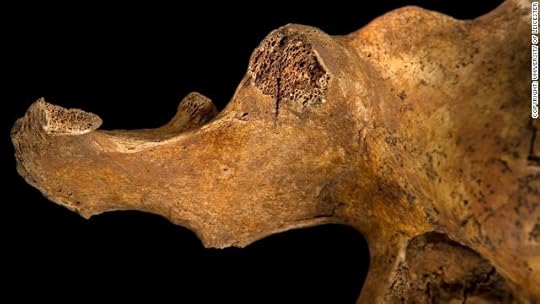 Unlike the victims of Towton there was no facial mutilation nor any attempt to remove ears as trophies such as seen on Towton 32.
Unlike the victims of Towton there was no facial mutilation nor any attempt to remove ears as trophies such as seen on Towton 32.This is because it is likely that Richard fell forward i.e. was killed from behind and also that there were orders to save his face for later recognition, possibly a direct order from Henry Tudor who was close by.
No defensive wounds have been found on Richard’s arms/forearms. These are the most common wounds and at Towton often seen on the forearms. (Not feinting blows as has been suggested - these are defensive - fending off attack and are instinctive).Therefore likely that Richard’s armour stayed intact until his death. Robert emphasized that there is still much work to be done and the final conclusions will not be delivered until late this year.
All photos Leicester University.

